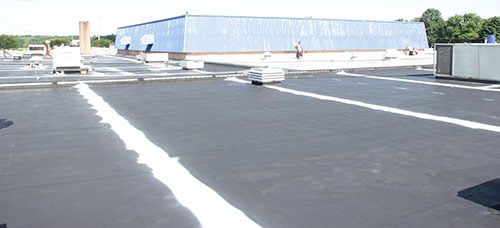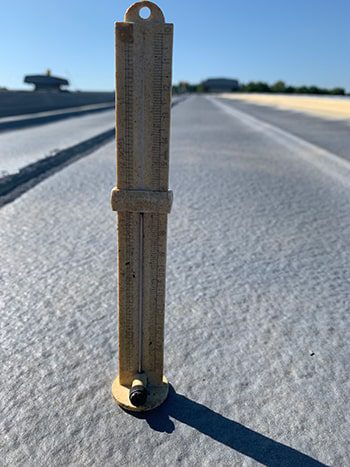Summary: The correct thickness of silicone coatings is determined by the manufacturer, who has done testing on how thick a coating will last for a warranty period. For example, they know that 20 mils of coating will outlast a 10-year warranty.
So, you’re interested in a silicone roof coating system for your commercial roof. But you’re wondering how thick this stuff should go on.
Perhaps you’re wondering if a thicker application is better?
In this article, we’ll talk about:
- Manufacturer specifications
- Warranty levels
- Coating thickness over seams
- Dry film thickness
- And how coating thickness is explained in a scope of work
West Roofing Systems has been applying silicone coating over commercial roofs since 1979. When we apply the coating, we work with the manufacturers to make sure the coating is applied to the thickness levels that will last the length of the warranty (and it’ll probably last longer than that though).
Let’s get started.
Silicone roof coating manufacturers determine thickness levels
Silicone roof coating manufacturers have extensive testing to where they know how long their coating is going to last.
There would be no point in selling a product that will only last 5 years but give out 10-year warranties. In years 6-10, they would be getting warranty claim after warranty claim and fixing roofs for free.
If a manufacturer says the product lasts 15 years, it probably lasts 20 so they are safe from any negative press.
Here are the standard thickness levels for silicone roof coatings:
- For a 10-year warranty, install 20 mils of coating over the field of the roof.
- For a 15-year warranty, install 25 mils of coating over the field of the roof.
- For a 20-year warranty, install 30 mils of coating over the field of the roof.
NOTE: These thickness levels can vary by manufacturer, climate, existing roof substrate, and more.
If you’re worried if the roofing contractor installed enough coating on your roof (because the difference between 20 mils and 25 mils is less than 1% of 1 inch), in most cases, the manufacturer of the coating will go on the roof after installation and measure the thickness levels.
If the warranty isn’t through the manufacturer, the contractor or a 3rd party will measure the thickness of the coating.
If the coating is light, they will make the contractor install more coating.
If more coating is installed than the specs say, then it’s favorable to the building owner. They will have a coating system that will last well past the warranty period, without paying more for it.
Silicone coating thickness over seams

On any roof that has seams (most likely metal and single-ply), special attention needs to occur at the seams since they have a high probability of leaking.
This is what’s called seam reinforcement and it usually happens in one of two ways:
#1 – Polyester Mesh with Coating
Install a polyester reinforced mesh into a liquid top coating, apply over seams, then apply additional silicone coating after the topcoat has cured.
#2 – Self-Adhesive Tape
You can reinforce the seams, flashings, and penetrations with a self-adhering, reinforcing tape that would then receive a liquid topcoat.
The thickness of the coating can vary when performing a seam reinforcement, but it’s usually 20-30 mils of coating.
Dry film thickness

If you get a scope of work from a roofing contractor, there may be a term used called “dry film thickness”.
According to Corrosionpedia:
“Dry film thickness (DFT) is the thickness of a coating as measured above the substrate. This can consist of a single layer or multiple layers.
DFT is measured for cured coatings (after the coating dries). Thickness of a coating depends on the application and type of process employed. Proper thickness should be determined by recommended coating system parameters.”
In summary, dry film thickness = the thickness of the coating after it’s cured.
If you get a scope of work from a roofing contractor, you may see something like this:
The silicone coating will be applied according to manufacturer specifications to achieve a minimum dry film thickness at approximately 15 mils. Allow the coating to cure. Inspect for thinly coated areas, uncured areas, or other defects. Any defects will be repaired before subsequent application of coating. The base coat will be clean, dry, sound, and free of dust, dirt, and other contaminants before application of the topcoat.
Apply High Solids Silicone topcoat promptly upon completion of base coat to ensure proper adhesion between coats. The topcoat will be applied per manufacturer specifications to achieve a minimum dry film thickness at approximately 15 mils.
NOTE: This roof received two layers of coating, a basecoat, and a topcoat, each 15 mils thick. With 30 mils of dry film thickness, it’s most likely this roof is geared towards receiving a 20-year warranty.
The thickness of silicone coatings and your next steps
If there’s one thing to take away from this post is that silicone roof coatings are installed to the thickness levels according to manufacturer specifications.
They have done the testing on all different roof systems, climates, high wind situations, high traffic situations, etc.
When the job is complete, if the warranty is going through the manufacturer, they will send a representative out to inspect that the coating was installed at the recommended thickness.
At West Roofing Systems, when we’ve seen a silicone-coated roof get a 15-year warranty, we’ve NEVER seen that coating wear completely out over that time.
They have all lasted longer. Especially if yearly maintenance has been performed.
Now on year #1, if 25 mils of silicone coating were installed, at year #15, there may be 7-10 mils of coating left…but never anywhere near 0.
Now that you know about coating thickness, what’s next?
Below is a “Cheat Sheet” about silicone roof coating systems. It includes:
- How much does a silicone roof coating system cost?
- What problems do they have?
- What advantages do they have over other roof systems?
- And some photos and videos of completed roofs!

